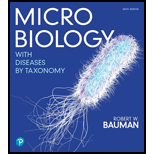
Microbiology With Diseases By Taxonomy Plus Mastering Microbiology With Pearson Etext -- Access Card Package (6th Edition)
6th Edition
ISBN: 9780135159927
Author: Robert W. Bauman Ph.D.
Publisher: PEARSON
expand_more
expand_more
format_list_bulleted
Question
Chapter 1, Problem 1MCFU
Summary Introduction
To determine: The way in which the Person P’s diagnostic conversation with physician Person A parallels the scientific method.
Introduction: Science is the method of “acquiring knowledge” based on facts learned through experiments and observations. The applications and research on science help to improve the standard of lives.
Expert Solution & Answer
Want to see the full answer?
Check out a sample textbook solution
Students have asked these similar questions
students in a science class investiged the conditions under which corn seeds would germinate most successfully. BAsed on the results which of these factors appears most important for successful corn seed germination.
I want to write the given physician orders in the kardex form
Amino
Acid Coclow
TABle
3'
Gly
Phe
Leu
(G)
(F) (L)
3-
Val
(V)
Arg (R)
Ser (S)
Ala
(A)
Lys (K)
CAG
G
Glu
Asp (E)
(D)
Ser
(S)
CCCAGUCAGUCAGUCAG
0204
C
U
A G
C
Asn
(N)
G
4
A
AGU
C
GU
(5)
AC
C
UGA
A
G5
C
CUGACUGACUGACUGAC
Thr
(T)
Met (M)
lle
£€
(1)
U
4
G
Tyr
Σε
(Y)
U
Cys (C)
C
A
G
Trp (W) 3'
U
C
A
Leu
בוט
His
Pro
(P)
££
(H)
Gin
(Q)
Arg
흐름
(R)
(L)
Start
Stop
8. Transcription and Translation Practice: (Video 10-1 and 10-2)
A. Below is the sense strand of a DNA gene. Using the sense strand, create the antisense
DNA strand and label the 5' and 3' ends.
B. Use the antisense strand that you create in part A as a template to create the mRNA
transcript of the gene and label the 5' and 3' ends.
C. Translate the mRNA you produced in part B into the polypeptide sequence making sure
to follow all the rules of translation.
5'-AGCATGACTAATAGTTGTTGAGCTGTC-3' (sense strand)
4
Chapter 1 Solutions
Microbiology With Diseases By Taxonomy Plus Mastering Microbiology With Pearson Etext -- Access Card Package (6th Edition)
Ch. 1 - What does the science of microbiology study?Ch. 1 - Are most microorganisms harmful or harmless to...Ch. 1 - Patty is a mother to 14-year-old twins and works...Ch. 1 - What scientific device did van Leeuwenhoek create?Ch. 1 - Prob. 2MICCh. 1 - Van Leeuwenhoek described bacteria, archaea,...Ch. 1 - All eukaryotic cells contain most of their genetic...Ch. 1 - What term describes the idea that living organisms...Ch. 1 - The investigations of which researcher finally...Ch. 1 - Today we understand that yeasts and bacteria can...
Ch. 1 - What industry has the work of Pasteur most...Ch. 1 - Which researcher ultimately gave us a method for...Ch. 1 - Which researcher developed the staining technique...Ch. 1 - Prob. 11MICCh. 1 - The use of antiseptic chemicals during surgical...Ch. 1 - Prob. 13MICCh. 1 - Some people consider Leeuwenhoek the Father of...Ch. 1 - Why might Nightingale be considered the Mother of...Ch. 1 - Prob. 3TMWCh. 1 - In the late 18th century, Philadelphia was one of...Ch. 1 - Emerging Disease Case Study Variant...Ch. 1 - Prob. 1MCFUCh. 1 - Dr. Andrews has a lot of questions tot Patty. When...Ch. 1 - Which of the following microorganisms are not...Ch. 1 - Prob. 2MCCh. 1 - In which habitat would you most likely find...Ch. 1 - Of the following scientists, who first promulgated...Ch. 1 - Which of the following scientists hypothesized...Ch. 1 - Prob. 6MCCh. 1 - Prob. 7MCCh. 1 - Prob. 8MCCh. 1 - Prob. 9MCCh. 1 - The laboratory of Robert Koch contributed which of...Ch. 1 - Prob. 1FIBCh. 1 - Prob. 2FIBCh. 1 - Chemotherapy _______________Ch. 1 - Prob. 4FIBCh. 1 - Infection control _______________Ch. 1 - Prob. 6FIBCh. 1 - Epidemiology _______________Ch. 1 - Biotechnology _______________Ch. 1 - Prob. 9FIBCh. 1 - Why was the theory of spontaneous generation a...Ch. 1 - Discuss the significant difference between the...Ch. 1 - List six types of microorganisms.Ch. 1 - Defend this statement: The investigations of...Ch. 1 - Why would a macroscopic tapeworm be studied in...Ch. 1 - Describe what has been called the Golden Age of...Ch. 1 - List four major questions that drive...Ch. 1 - Prob. 8SACh. 1 - Prob. 9SACh. 1 - What does the term HAI (nosocomial infection) have...Ch. 1 - Match each of the following descriptions with the...Ch. 1 - Prob. 1VICh. 1 - Prob. 2VICh. 1 - If Robert Koch had become interested in a viral...Ch. 1 - In 1911, the Polish scientist Casimir Funk...Ch. 1 - Haemophilus influenzae does not cause flu, but it...Ch. 1 - Just before winter break in early December, your...Ch. 1 - Design an experiment to prove that microbes do not...Ch. 1 - Prob. 6CTCh. 1 - Compare and contrast the investigations of Redi,...Ch. 1 - If you were a career counselor directing a student...Ch. 1 - A few bacteria produce disease because they derive...Ch. 1 - How might the debate over spontaneous generation...Ch. 1 - French microbiologists, led by Pasteur, tried to...Ch. 1 - Why arent Kochs postulates always useful in...Ch. 1 - Albert Kluyver said, From elephant to ......Ch. 1 - The ability of farmers around the world to produce...Ch. 1 - Prob. 15CTCh. 1 - Using the following terms, fill in the following...
Knowledge Booster
Similar questions
- What is the structure and function of Eukaryotic cells, including their organelles? How are Eukaryotic cells different than Prokaryotic cells, in terms of evolution which form of the cell might have came first? How do Eukaryotic cells become malignant (cancerous)?arrow_forwardWhat are the roles of DNA and proteins inside of the cell? What are the building blocks or molecular components of the DNA and proteins? How are proteins produced within the cell? What connection is there between DNA, proteins, and the cell cycle? What is the relationship between DNA, proteins, and Cancer?arrow_forwardWhy cells go through various types of cell division and how eukaryotic cells control cell growth through the cell cycle control system?arrow_forward
- In one paragraph show how atoms and they're structure are related to the structure of dna and proteins. Talk about what atoms are. what they're made of, why chemical bonding is important to DNA?arrow_forwardWhat are the structure and properties of atoms and chemical bonds (especially how they relate to DNA and proteins).arrow_forwardThe Sentinel Cell: Nature’s Answer to Cancer?arrow_forward
- Molecular Biology Question You are working to characterize a novel protein in mice. Analysis shows that high levels of the primary transcript that codes for this protein are found in tissue from the brain, muscle, liver, and pancreas. However, an antibody that recognizes the C-terminal portion of the protein indicates that the protein is present in brain, muscle, and liver, but not in the pancreas. What is the most likely explanation for this result?arrow_forwardMolecular Biology Explain/discuss how “slow stop” and “quick/fast stop” mutants wereused to identify different protein involved in DNA replication in E. coli.arrow_forwardMolecular Biology Question A gene that codes for a protein was removed from a eukaryotic cell and inserted into a prokaryotic cell. Although the gene was successfully transcribed and translated, it produced a different protein than it produced in the eukaryotic cell. What is the most likely explanation?arrow_forward
arrow_back_ios
SEE MORE QUESTIONS
arrow_forward_ios
Recommended textbooks for you
- Understanding Health Insurance: A Guide to Billin...Health & NutritionISBN:9781337679480Author:GREENPublisher:Cengage
 Nutrition Through The Life CycleHealth & NutritionISBN:9781337919333Author:Brown, Judith E.Publisher:Cengage Learning,
Nutrition Through The Life CycleHealth & NutritionISBN:9781337919333Author:Brown, Judith E.Publisher:Cengage Learning, Medical Terminology for Health Professions, Spira...Health & NutritionISBN:9781305634350Author:Ann Ehrlich, Carol L. Schroeder, Laura Ehrlich, Katrina A. SchroederPublisher:Cengage Learning
Medical Terminology for Health Professions, Spira...Health & NutritionISBN:9781305634350Author:Ann Ehrlich, Carol L. Schroeder, Laura Ehrlich, Katrina A. SchroederPublisher:Cengage Learning


Understanding Health Insurance: A Guide to Billin...
Health & Nutrition
ISBN:9781337679480
Author:GREEN
Publisher:Cengage


Nutrition Through The Life Cycle
Health & Nutrition
ISBN:9781337919333
Author:Brown, Judith E.
Publisher:Cengage Learning,


Medical Terminology for Health Professions, Spira...
Health & Nutrition
ISBN:9781305634350
Author:Ann Ehrlich, Carol L. Schroeder, Laura Ehrlich, Katrina A. Schroeder
Publisher:Cengage Learning